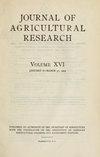CHANGES IN MICROBIOLOGICAL QUALITY AND SAFETY OF VACUUM-PACKED COLD-SMOKED SALMON (Salmo salar) DURING STORAGE
引用次数: 0
Abstract
The first aim of this study was to assess the microbiological quality and safety of ten different brand samples of vacuum-packed cold-smoked salmon, CSS (n=50) from supermarkets of two cities in Egypt. The second aim of the current study was to study the changes in the microbiological quality and safety of CSS (Salmo salar) that obtained from one factory located in 10 th Ramadan City after their directly production. Samples from the factory were stored at 5 and 0°C and then examined after 0, 7, 14, 21, 28 and 35 days of storage. For all samples, microbiological parameters [total bacterial counts (TBC), total lactic acid bacteria (LAB), lactobacilli count, Pseudomonas group and Enterobacteriaceae count] were performed at the same time. Pathogenic microorganisms (Staphylococcus aureus and Listeria spp.) were examined in all samples. These pathogenic bacteria were not detected in all factory samples tested and during the time of storage. The TBC, LAB, lactobacilli count, Pseudomonas group and Enterobacteriaceae family showed a significant increase with storage time and temperature regimes. Shelf lives of smoked salmon stored at 0 and 5°C were 26 and 8 days, respectively. Lactobacillus spp. and Pseudomonas spp. were dominant in terms of deterioration in quality.真空包装冷熏鲑鱼贮藏期间微生物质量和安全性的变化
本研究的第一个目的是评估来自埃及两个城市超市的10种不同品牌的真空包装冷熏鲑鱼样品的微生物质量和安全性,CSS (n=50)。本研究的第二个目的是研究从第10斋月市的一家工厂获得的CSS (Salmo salar)直接生产后微生物质量和安全性的变化。工厂样品在5°C和0°C下保存,然后在0、7、14、21、28和35天后检查。同时测定所有样品的微生物学参数[细菌总数(TBC)、乳酸菌总数(LAB)、乳酸菌总数、假单胞菌群和肠杆菌科细菌总数]。所有样品均检测了病原微生物(金黄色葡萄球菌和李斯特菌)。这些致病菌未在所有出厂样品和储存期间检测到。TBC、LAB、乳酸菌数量、假单胞菌群和肠杆菌科均随贮藏时间和温度的升高而显著升高。在0°C和5°C条件下,熏鲑鱼的保质期分别为26天和8天。以乳酸菌和假单胞菌为主。
本文章由计算机程序翻译,如有差异,请以英文原文为准。
求助全文
约1分钟内获得全文
求助全文

 求助内容:
求助内容: 应助结果提醒方式:
应助结果提醒方式:


